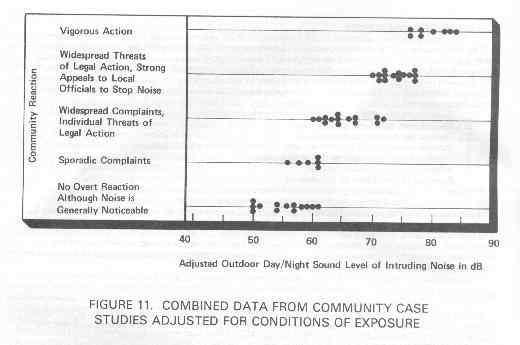Developing a new Healdsburg Noise Ordinance
![]()
EPA Studies - Community Reactions to Noise
Excerpts from; "Information on Levels of Environmental Noise Requisite to Protect Public Health and Welfare with an Adequate Margin of Safety," EPA/ONAC 550/9-74-004, March, 1974.
"Two major indices of the cumulative effects of environmental noise on people are (A) specific actions taken by individuals or groups (such as complaints), and (B) responses to social survey questionnaires. Over the last 25 years, numerous studies have been conducted to increase understanding of the relationship between noise exposure and its effects on people in communities.
Several factors beyond the magnitude of exposure have been found to influence community reaction. These factors include:
1. Duration of intruding noises and frequency of
occurrence
2. Time of year (windows open or closed)
3. Time of day of noise exposure
4. Outdoor noise level in community when intruding noises are not present
5. History of prior exposure to the noise source
6. Attitude toward the noise source
7. Presence of pure tones or impulses.
Since each of these factors may affect community reactions to noise exposure, adjustments for each have been developed to improve the predictability of community reactions beyond that available from a simple measure of exposure level. Figure 11 shows the results of several different case studies, relating Ldn (in dB) to community response with various correction factors added. The addition of the correction factors makes it possible to predict community reaction to within + 5 dB. As is common with annoyance and interference caused by noise, the effects of context and situation may be almost as important as the magnitude or intensity of the source. Caution is also needed in applying these relationships to communities that are significantly quieter than average urban areas."
[
Healdsburg is one of those communities that are much quieter than urban, and
most suburban areas. This is important when it comes time to establish maximum
sound levels in our new noise ordinance! ]

[
Keep in mind Figure 11 is
calculated as Ldn. This is the average noise over a 24 hour period. A
giant explosion next door would only result in a tiny change in the measurement
because that sound is averaged with all other sounds in that day. The sum of
daily Ldn numbers is then averaged for an entire year, once again resulting in a
lower overall number.]
Q. Is
annoyance simply a
"welfare" effect?
A. Annoyance is a reflection of adverse effects which cannot be ascribed solely
to "health" or "welfare." "Public health and welfare" in the context of the
Noise Control Act is an indivisible term; there are no separate "health" effects
or "welfare" effects. "Public health and welfare" includes personal comfort and
well-being, and the absence of mental anguish, disturbances and annoyance as
well as the absence of clinical symptoms such as hearing loss or demonstrable
physiological injury.
Q. What is annoyance due to noise?
A. Noise annoyance may be viewed as any negative subjective reaction to noise on
the part of an individual or group. It is not an indication of weakness or
inability to cope with stress on the part of the annoyed. More likely it
signifies transient (or possibly lasting) stress beyond the control of the
conscious individual. This is often expressed on social surveys as the
percentage of people who express differing degrees of disturbance or
dissatisfaction due to the noisiness of their environments. For the purpose of
identifying protective noise levels, annoyance is quantified by using the
percentage of people who are annoyed by noise. This is felt to be the best
estimate of the average general adverse response of people, and in turn, is
viewed as reflecting activity interference and the overall desire for quiet.
Q. Are people annoyed at levels below an Ldn of 45 or 55 dB?
Individuals, or even groups, may be annoyed by noise at low levels-the dripping
faucet or humming fluorescent bulb are good examples. Annoyance depends very
much on the situation, and on individual differences and noise durations.
Q. What do complaints represent?
A. Complaints are used by officials as an indication that a noise problem exists
(although a noise problem may well exist in the absence of specific complaints).
However, they do not necessarily represent the magnitude of a noise problem.
The number of people who file complaints is only a very
small percentage of those who are annoyed.
![]() BACK TO ourHealdsburg.com
BACK TO ourHealdsburg.com
![]() BACK to NOISE page
BACK to NOISE page
webmaster:
![]() thomasjoad@ourHealdsburg.com
thomasjoad@ourHealdsburg.com
© 2002 ourHealdsburg.com™. All rights reserved.